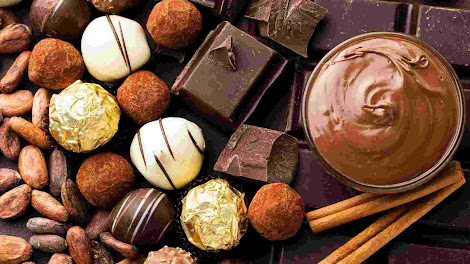The Sweet Journey of Chocolates: Exploring Its Rich History and Irresistible Delights
Hey there, chocolate enthusiasts! Did you know that the delectable treat we call chocolate has a fascinating history that spans centuries? From its humble beginnings in ancient Mesoamerica to its worldwide popularity today, chocolate has captured the hearts (and taste buds) of people around the globe.
In this blog post, we're embarking on a sweet journey through time to explore the rich history of chocolates. We'll dive into its origins, trace its evolution, and discover how it has become an irresistible delight for chocolate lovers everywhere.
Now, let's delve into the first chapter of this chocolate saga.
Section I: Ancient Beginnings: The Origins of Chocolate
Welcome to the ancient world of chocolate! Long before it became the irresistible treat we know today, chocolate had its origins in Mesoamerica, a region that encompassed present-day Mexico and parts of Central America.
Thousands of years ago, the cacao tree flourished in the tropical rainforests of this region. The cacao pods, resembling large melons, contained precious cacao beans, which would eventually be transformed into the chocolate we adore.
The story of chocolate begins with the Olmecs, an ancient civilization that thrived around 1500 BCE. They were the first to discover the cacao beans and their potential. But it was the Mayans who truly embraced and cultivated cacao, incorporating it into their daily lives and rituals.
For the Mayans, cacao was more than just a tasty treat. It held immense cultural and spiritual significance. They believed that cacao had divine qualities and used it in religious ceremonies, as currency, and even as a beverage called "xocoatl." This bitter, frothy concoction was made by grinding cacao beans and mixing them with water, chili peppers, and other spices. It was quite different from the sweet chocolate drinks we enjoy today!
Section II: Arrival in Europe: Chocolate's Journey across the Atlantic
Fasten your seatbelts as we embark on a transatlantic voyage with chocolate! Our sweet treat made its way from the shores of Mesoamerica to the bustling cities of Europe, thanks to the daring explorers of the Age of Discovery.
It was Christopher Columbus who first encountered cacao beans during his fourth voyage to the Americas in 1502. Although he didn't recognize their true value at the time, he brought some back to Europe, unknowingly setting in motion the introduction of chocolate to a whole new world.
Once on European soil, chocolate caught the attention of Spanish conquistadors, who were quick to recognize its potential. The Spanish royalty, in particular, took a liking to this exotic new beverage. They kept it a secret from the rest of Europe for almost a century, savoring its unique flavors behind palace doors.
But secrets can't stay hidden forever. By the 17th century, chocolate began to make its way beyond royal courts and into the hearts of the common people. The Spanish brought the cacao beans to their American colonies, where they started establishing cacao plantations and experimenting with new recipes.
Meanwhile, in Europe, chocolate found a new home within the walls of convents. The nuns became master chocolatiers, skillfully preparing chocolate drinks and treats. They added spices, vanilla, and even honey to enhance the flavors. The popularity of chocolate spread like wildfire, captivating the taste buds of Europeans from all walks of life.
Section III: Industrial Revolution: Mass Production and Commercialization
Hold on tight as we enter the era of industrialization, where chocolate undergoes a remarkable transformation. The Industrial Revolution, with its technological advancements, revolutionized the production and accessibility of chocolate, turning it into a mass-produced delight for the masses.
During the 18th and 19th centuries, ingenious inventors and entrepreneurs propelled chocolate-making into a whole new era. They developed machines that could grind cacao beans more efficiently, creating a smoother texture. This process, known as conching, became a game-changer in chocolate production.
The introduction of solid chocolate was another groundbreaking development. Before this innovation, chocolate was primarily consumed as a beverage. But now, chocolate bars and confectionery treats became accessible to a wider audience, satisfying their sweet cravings like never before.
In the midst of this chocolate revolution, Swiss chocolatiers emerged as pioneers of quality and innovation. The Swiss, renowned for their precision and craftsmanship, elevated chocolate-making to an art form. They experimented with new techniques, including the invention of milk chocolate, which combined the richness of cacao with the creaminess of milk.
One name that stands out during this period is Rudolf Lindt, a Swiss chocolatier who perfected the conching process, resulting in smooth and melt-in-your-mouth chocolate. Lindt's contributions to the industry revolutionized the way we experience chocolate, setting the standard for quality and indulgence.
Section IV: Chocolate Goes Global: Cultural Influences and International Appeal
Fast forward to the modern era, where chocolate has become a global sensation, transcending borders and delighting taste buds across continents. Let's explore the cultural influences and international appeal that have shaped the world of chocolate.
In the Americas, the love affair with chocolate continued to evolve. American chocolate giants like Hershey's played a significant role in making chocolate accessible to the masses. Through innovative manufacturing processes and clever marketing, they brought chocolate bars and candies into the hands of millions, creating a chocolate revolution of their own.
Meanwhile, in Belgium, a country known for its artistry and craftsmanship, chocolatiers honed their skills and elevated chocolate-making to a whole new level. Belgian chocolates, particularly their pralines and truffles, became synonymous with indulgence and luxury. These exquisite creations, with their delicate flavors and stunning designs, captivated chocolate enthusiasts around the world.
But chocolate's global journey doesn't end there. Different cultures and regions have their own unique chocolate traditions and specialties. From Mexico's rich and spicy hot chocolate to Italy's decadent chocolate gelato, each country puts its own twist on this beloved treat.
In addition to regional variations, there are also unique chocolate experiences to be found in various corners of the world. For example, in Switzerland, you can indulge in a rich and velvety cup of Swiss hot chocolate, while in Japan, you can discover the art of creating intricate and adorable chocolate treats.
Section V: Modern Trends: Health Benefits and Sustainable Practices
Now, let's shift our focus to the modern trends surrounding chocolate. While we all adore its irresistible taste, there has been much discussion about the potential health benefits and the importance of sustainable practices in chocolate production.
You may have heard claims about the health benefits of chocolate, but are they too good to be true? Well, there is some truth to it. Chocolate, particularly dark chocolate with a high cocoa content, contains antioxidants that may have positive effects on our health. These antioxidants, called flavonoids, have been associated with reducing the risk of heart disease and improving brain function. However, it's important to note that moderation is key. Consuming excessive amounts of chocolate can still contribute to weight gain and other health issues.
Beyond personal health, there is also growing awareness about the impact of chocolate production on the environment and the welfare of cocoa farmers. Cocoa farming, primarily taking place in West Africa, faces challenges such as deforestation, child labor, and unfair trade practices. To address these issues, the concept of fair trade has emerged, ensuring that cocoa farmers receive fair wages and work under ethical conditions.
Moreover, sustainable practices are gaining momentum in the chocolate industry. From bean-to-bar movement to certifications like Rainforest Alliance and UTZ, there is a focus on responsible sourcing, environmental conservation, and social responsibility. These efforts aim to create a more sustainable and ethical chocolate industry that benefits both the planet and the people involved in its production.
★ Here are Some Frequently Asked Questions (FAQs)
1. Is chocolate good for your health?
- While chocolate, especially dark chocolate with a high cocoa content, contains antioxidants that may have health benefits, moderation is key. Consuming excessive amounts of chocolate can still contribute to weight gain and other health issues.
2. What is the difference between milk chocolate and dark chocolate?
- The main difference lies in the ingredients. Milk chocolate contains milk powder or condensed milk, giving it a creamier and sweeter taste. Dark chocolate has little to no milk solids and a higher percentage of cocoa, resulting in a richer and slightly bitter flavor.
3. How is chocolate made?
- Chocolate is made from the cacao tree's beans. After harvesting, the beans undergo fermentation and drying processes. They are then roasted, ground into a paste called chocolate liquor, and further processed to separate the cocoa solids from the cocoa butter. Additional ingredients such as sugar, milk powder, and flavorings are added to create different types of chocolate.
4. What is fair trade chocolate?
- Fair trade chocolate ensures that cocoa farmers receive fair wages and work under ethical conditions. It aims to address issues such as child labor, poverty, and environmental sustainability in the cocoa industry. By purchasing fair trade chocolate, consumers can support these efforts and contribute to a more equitable chocolate industry.
5. How can I identify sustainable chocolate?
- Look for certifications such as Rainforest Alliance, UTZ, or Fairtrade on the chocolate packaging. These certifications indicate that the chocolate has been produced using sustainable practices, including responsible sourcing, environmental conservation, and social responsibility.
6. What are some popular chocolate destinations to visit?
- Switzerland, Belgium, and France are renowned for their chocolate-making traditions and offer a range of delightful chocolate experiences. Other countries with notable chocolate scenes include Italy, Mexico, and the United States.
Final Thoughts
And there you have it, the sweet journey of chocolates from its ancient origins to its modern-day allure. We've traveled through time, exploring the rich history, cultural influences, and global appeal of this beloved treat.
From the ancient Mesoamerican civilizations who first discovered the magic of cacao to the European explorers who brought it across the Atlantic, chocolate has captured the hearts and palates of people around the world. Through the Industrial Revolution, it became a mass-produced delight, and Swiss chocolatiers elevated it to an art form.
As chocolate went global, American chocolate giants like Hershey's made it accessible to the masses, while Belgian chocolatiers wowed us with their intricate pralines and truffles. Each country and region added its own unique flavors and traditions to the chocolate experience.
In the modern era, we've become more aware of the potential health benefits of chocolate, particularly dark chocolate, with its antioxidants and flavonoids. At the same time, there is a growing emphasis on sustainable practices and fair trade, ensuring that chocolate production respects the environment and the welfare of cocoa farmers.
So, whether you savor a rich piece of Swiss chocolate, enjoy the sweetness of Belgian pralines, or indulge in a classic American chocolate bar, one thing is certain: chocolate is a universal pleasure that brings joy to people across borders and cultures.
As we conclude this sweet adventure, we invite you to continue exploring the world of chocolate. Discover new flavors, support ethical brands, and savor each delicious bite. Chocolate truly is a timeless delight that never fails to make life a little sweeter.
THANK YOU FOR READING!!
FOLLOW FOR MORE INTERESTING CONTENT








.jpg)





